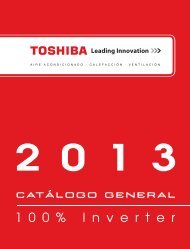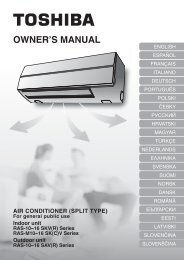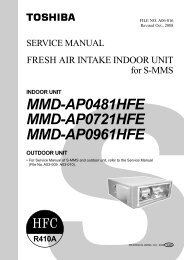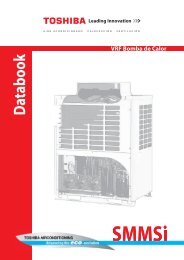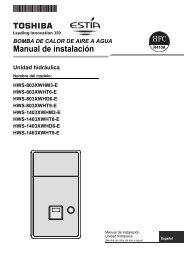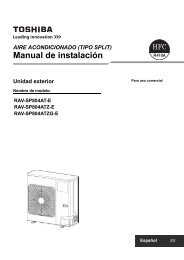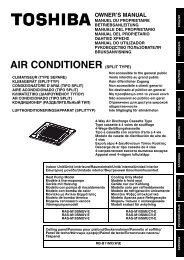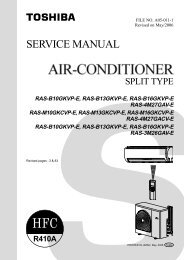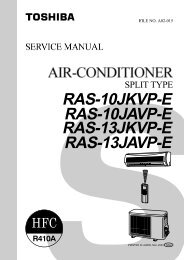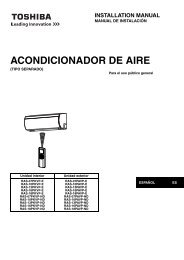RAV-SM561KRT-E RAV-SM801KRT-E
RAV-SM561KRT-E RAV-SM801KRT-E
RAV-SM561KRT-E RAV-SM801KRT-E
Create successful ePaper yourself
Turn your PDF publications into a flip-book with our unique Google optimized e-Paper software.
AIR CONDITIONER (SPLIT TYPE)<br />
CLIMATISEUR (TYPE SPLIT)<br />
KLIMAGERÄT (SPLIT-SYSTEM)<br />
CONDIZIONATORE D’ARIA (TIPO MULTIAMBIENTI)<br />
APARATO DE AIRE ACONDICIONADO (TIPO SPLIT)<br />
AR CONDICIONADO (TIPO SPLIT)<br />
AIRCONDITIONER (GESPLITST TYPE)<br />
ΚΛΙΜΑΤΙΣΤΙΚΟ ΜΗΧΑΝΗΜΑ (∆ΙΑΙΡΟΎΜΕΝΟΣ ΤΎΠΟΣ)<br />
INSTALLATION MANUAL<br />
MANUEL D’INSTALLATION<br />
INSTALLATIONS-HANDBUCH<br />
MANUALE D’INSTALLAZIONE<br />
MANUAL DE INSTALACIÓN<br />
MANUAL DE INSTALAÇÃO<br />
INSTALLATIEHANDLEIDING<br />
ΕΓΧΕΙΡΙ∆ΙΟ ΕΓΚΑΤΑΣΤΑΣΗΣ<br />
/<br />
/<br />
/<br />
/<br />
Heat Pump Model/Modèle à thermopompe<br />
Geräte mit Heizung/Modello con pompa di riscaldamento<br />
Modelo con bomba de calor/Modelo de bomba térmica<br />
Model met warmtepomp/Μοντέλο µε Αντλία Θερµότητας<br />
Indoor Unit/Unité intérieure<br />
Raumeinheit/Unità interna<br />
Unidad interior/Unidade interior<br />
Binnenunit/Εσωτερική Μονάδα<br />
<strong>RAV</strong>-<strong>SM561KRT</strong>-E<br />
<strong>RAV</strong>-<strong>SM801KRT</strong>-E<br />
3<br />
Please read this Installation Manual carefully before installing the Air Conditioner.<br />
• This Manual describes the installation method of the indoor unit.<br />
• For installation of the outdoor unit, follow the Installation Manual attached to the<br />
outdoor unit.<br />
Veuillez lire attentivement ce Manuel d’installation avant d’installer le climatiseur.<br />
• Ce manuel décrit la procédure d’installation de l’unité intérieure.<br />
• Pour installer l’unité extérieure, reportez-vous au Manuel d’installation fourni avec<br />
l’unité extérieure.<br />
Bitte lesen Sie dieses Handbuch sorgfältig, bevor Sie mit der Installation des Klimagerätes beginnen.<br />
• In diesem Handbuch wird die Installation der Raumeinheit beschrieben.<br />
• Um die Außeneinheit zu installieren, folgen Sie den Anweisungen in dem Handbuch, das der Außeneinheit beiliegt.<br />
Prima di installare il condizionatore d’aria, leggere con attenzione questo manuale d’installazione.<br />
• Questo manuale descrive il metodo d’installazione dell’unità interna.<br />
• Per l’installazione dell’unità esterna, fare riferimento al manuale d’installazione fornito insieme all’unità esterna.<br />
Lea atentamente este Manual de instalación antes de proceder a la instalación del aparato de aire acondicionado.<br />
• Este manual describe el método de instalación de la unidad interior.<br />
• Para la instalación de la unidad exterior, consulte el Manual de instalación que acompaña a la unidad exterior.<br />
Leia atentamente o presente Manual de Instalação antes de instalar o Ar Condicionado.<br />
• O presente manual descreve o método de instalar a unidade interior.<br />
• Para a instalação de uma unidade exterior, siga o Manual de Instalação que acompanha a unidade exterior.<br />
Lees deze installatiehandleiding zorgvuldig door voordat u de airconditioner gaat installeren.<br />
• Deze installatiemethode beschrijft de installatiemethode van de binnenunit.<br />
• Zie voor de installatie van de buitenunit, de installatiehandleiding bij de buitenunit.<br />
Παρακαλώ διαßάστε προσεχτικά το Ενχειρίδιο Ενκατάστασης πριν από την ενκατασταση του Κλιµατιστικού.<br />
• Το παρόν Ενχειρίδιο περινράφει τη µέθοδο ενκατάστασης της εσωτερικής µονάδας.<br />
• Για την ενκατάσταση της εξωθερικής µονάδας, ακολουθήστε το Ενχειρίδιο Ενκατάστασης που συνοδεύει<br />
την εξωτερική µονάδα.<br />
Toshiba 1074007701_COVER 3<br />
7/16/04, 13:38<br />
TOSHIBA <strong>RAV</strong>-<strong>SM561KRT</strong>-E (EN) 1074007701
ADOPTION OF NEW REFRIGERANT<br />
• This Air Conditioner is a new type which adopts a new refrigerant HFC (R410A) instead of the conventional<br />
refrigerant R22 in order to prevent destruction of the ozone layer.<br />
UTILISATION DU NOUVEAU REFRIGERANT<br />
• Ce climatiseur est d’un type inédit qui utilise le nouveau réfrigérant HFC (R410A) au lieu du réfrigérant<br />
traditionnel R22, afin d’éviter la destruction de la couche d’ozone.<br />
EINFÜHRUNG EINES NEUEN KÜHLMITTELS<br />
• Dies ist ein neuartiges Klimagerät. Anstatt des herkömmlichen Kühlmittels R22 verwendet es das neue<br />
ozonschicht-schonende HFC Kühlmittel R410A.<br />
ADOZIONE DI UN NUOVO REFRIGERANTE<br />
• Questo condizionatore d’aria è di un tipo nuovo che adotta un nuovo refrigerate HFC (R410A) al posto del<br />
refrigerante convenzionale R22, per prevenire la distruzione dello strato di ozono dell’atmosfera terrestre.<br />
ADOPCIÓN DE NUEVO REFRIGERANTE<br />
• Este aparato de aire acondicionado es un modelo reciente que incorpora el nuevo refrigerante HFC (R410A) en<br />
lugar del refrigerante convencional R22 para así evitar daños en la capa de ozono.<br />
ADOPÇÃO DO NOVO REFRIGERANTE<br />
• Este ar condicionado é um modelo novo que adopta um novo refrigerante HFC (R410A) em vez do refrigerante<br />
convencional R22 para evitar a destruição da cama de ozono.<br />
TOEPASSING VAN EEN NIEUW KOELMIDDEL<br />
• Deze airconditioner is een nieuwe type dat werkt met een nieuw koelmiddel HFC (R410A) in plaats van met het<br />
conventionele koelmiddel R22, als bijdrage om de aantasting van de ozonlaag te reduceren.<br />
YIOΘETHΣH NEOY ΨYKTIKOY<br />
• To παρόv Kλιµατιστικό είναι νέος τύπος που υιοθετεί νέο ψυκτικό HFC (R410A) στη θέση του<br />
συµβατικού ψυκτικού R22 προκειµένου να βοηθήσει στην προστασία του όζοντος.<br />
3<br />
Toshiba 1074007701_TOC 2<br />
7/16/04, 13:38<br />
TOSHIBA <strong>RAV</strong>-<strong>SM561KRT</strong>-E (EN) 1074007701
Accessory parts and parts to be procured locally .................... 1<br />
1 PRECAUTIONS FOR SAFETY .............................................. 2<br />
2 INSTALLATION PROCEDURE .............................................. 4<br />
3 SELECTION OF INSTALLATION PLACE ............................. 5<br />
4 INSTALLATION OF INDOOR UNIT ....................................... 5<br />
5 DRAIN PIPING WORK ........................................................... 6<br />
CONTENTS<br />
6 REFRIGERANT PIPING ......................................................... 8<br />
7 ELECTRICAL WORK ........................................................... 11<br />
8 TEST RUN ............................................................................ 14<br />
9 TROUBLESHOOTING .......................................................... 15<br />
10 INDOOR UNIT OPERATION WHEN<br />
CONNECTED TO MULTIPLE UNITS ................................... 17<br />
ENGLISH<br />
FRANÇAIS<br />
DEUTSCH<br />
ITALIANO<br />
ESPAÑOL<br />
PORTUGUÊS<br />
NEDERLANDS<br />
3<br />
EΛΛΗΝΙΚΑ<br />
Toshiba 1074007701_TOC 3<br />
7/16/04, 13:39<br />
TOSHIBA <strong>RAV</strong>-<strong>SM561KRT</strong>-E (EN) 1074007701
Accessory parts and parts to be procured locally<br />
❑ Accessory parts<br />
Part<br />
No.<br />
Part name Q’ty Shape<br />
Part<br />
No.<br />
Part name Q’ty Shape<br />
1 Installation plate 1<br />
6 Service contact 1<br />
address label<br />
2 Installation Manual 1<br />
7 Wireless remote 1<br />
control<br />
3 Owner’s Manual 1<br />
8 Remote control 1<br />
holder<br />
4 Mounting screw 8<br />
∅4 mm x 25 mm<br />
9 Screw for remote 2<br />
control holder<br />
5 Pattern paper 1<br />
Wired remote controller is an optional part sold separately.<br />
❑ Parts to be procured locally<br />
Connecting pipe (Liquid side)<br />
(6.35 mm (diam.), Nominal (diam.) 1/4" thick 0.8 mm)<br />
<strong>RAV</strong>-<strong>SM561KRT</strong>-E<br />
(9.52 mm (diam.), Nominal (diam.) 3/8" thick 0.8 mm)<br />
<strong>RAV</strong>-<strong>SM801KRT</strong>-E<br />
Connecting pipe (Gas side)<br />
(12.7 mm (diam.), Nominal (diam.) 1/2" thick 0.8 mm)<br />
<strong>RAV</strong>-<strong>SM561KRT</strong>-E<br />
(15.9 mm (diam.), Nominal (diam.) 5/8" thick 1.0 mm)<br />
<strong>RAV</strong>-<strong>SM801KRT</strong>-E<br />
Connecting cable<br />
H07RN-F or 245IEC66 (1.5 mm 2 or more)<br />
Thermal insulation for refrigerant pipe<br />
(10 mm or more, thermal insulating foam polyethylene)<br />
Thermal insulation for drain pipe<br />
(10 mm or more, foam polyethylene)<br />
Drain pipe (Outer 16 mm (diam.))<br />
Tapes<br />
Grounding cable (2.0 mm (diam.) or more)<br />
3<br />
EN<br />
1<br />
Toshiba 1074007701(01EN)_P01-10 2<br />
7/16/04, 13:30<br />
TOSHIBA <strong>RAV</strong>-<strong>SM561KRT</strong>-E (EN) 1074007701
1 PRECAUTIONS FOR SAFETY<br />
• Ensure that all Local, National and International regulations are satisfied.<br />
• Read this “PRECAUTIONS FOR SAFETY” carefully before Installation.<br />
• The precautions described below include the important items regarding safety. Observe them without fail.<br />
• After the installation work, perform a trial operation to check for any problem.<br />
Follow the Owner’s Manual to explain how to use and maintain the unit to the customer.<br />
• Turn off the main power supply switch (or breaker) before the unit maintenance.<br />
• Ask the customer to keep the Installation Manual together with the Owner’s Manual.<br />
ENGLISH<br />
CAUTION<br />
New refrigerant air conditioner installation<br />
• THIS AIR CONDITIONER ADOPTS THE NEW HFC REFRIGERANT (R410A) WHICH DOES NOT DESTROY<br />
OZONE LAYER.<br />
The characteristics of R410A refrigerant are ; easy to absorb water, oxidizing membrane or oil, and its pressure<br />
is approx. 1.6 times higher than that of refrigerant R22. Accompanied with the new refrigerant, refrigerating oil<br />
has also been changed. Therefore, during installation work, be sure that water, dust, former refrigerant, or<br />
refrigerating oil does not enter the refrigerating cycle.<br />
To prevent charging an incorrect refrigerant and refrigerating oil, the sizes of connecting sections of charging<br />
port of the main unit and installation tools are charged from those for the conventional refrigerant.<br />
Accordingly the exclusive tools are required for the new refrigerant (R410A).<br />
For connecting pipes, use new and clean piping designed for R410A, and please care so that water or dust does<br />
not enter. Moreover, do not use the existing piping because there are problems with pressure-resistance force<br />
and impurity in it.<br />
CAUTION<br />
To disconnect the appliance from main power supply<br />
This appliance must be connected to the main power supply by means of a switch with a contact separation of<br />
at least 3 mm.<br />
The installation fuse (25A D type ) must be used for the power supply line of this conditioner.<br />
WARNING<br />
• Ask an authorized dealer or qualified installation professional to install/maintain the air conditioner.<br />
Inappropriate installation may result in water leakage, electric shock or fire.<br />
• Turn off the main power supply switch or breaker before attempting any electrical work.<br />
Make sure all power switches are off. Failure to do so may cause electric shock.<br />
• Connect the connecting cable correctly.<br />
If the connecting cable is connected in a wrong way, electric parts may be damaged.<br />
• When moving the air conditioner for the installation into another place, be very careful not to enter any<br />
gaseous matter other than the specified refrigerant into the refrigeration cycle.<br />
If air or any other gas is mixed in the refrigerant, the gas pressure in the refrigeration cycle becomes<br />
abnormally high and it may resultingly causes pipe burst and injuries on persons.<br />
• Do not modify this unit by removing any of the safety guards or by by-passing any of the safety<br />
interlock switches.<br />
• Exposure of unit to water or other moisture before installation may cause a short-circuit of electrical<br />
parts.<br />
Do not store it in a wet basement or expose to rain or water.<br />
3<br />
2<br />
EN<br />
Toshiba 1074007701(01EN)_P01-10 3<br />
7/16/04, 13:30<br />
TOSHIBA <strong>RAV</strong>-<strong>SM561KRT</strong>-E (EN) 1074007701
1 PRECAUTIONS FOR SAFETY<br />
• After unpacking the unit, examine it carefully if there are possible damage.<br />
• Do not install in a place that might increase the vibration of the unit.<br />
• To avoid personal injury (with sharp edges), be careful when handling parts.<br />
• Perform installation work properly according to the Installation Manual.<br />
Inappropriate installation may result in water leakage, electric shock or fire.<br />
• When the air conditioner is installed in a small room, provide appropriate measures to ensure that the<br />
concentration of refrigerant leakage occur in the room does not exceed the critical level.<br />
• Install the air conditioner securely in a location where the base can sustain the weight adequately.<br />
• Perform the specified installation work to guard against an earthquake.<br />
If the air conditioner is not installed appropriately, accidents may occur due to the falling unit.<br />
• If refrigerant gas has leaked during the installation work, ventilate the room immediately.<br />
If the leaked refrigerant gas comes in contact with fire, noxious gas may generate.<br />
• After the installation work, confirm that refrigerant gas does not leak.<br />
If refrigerant gas leaks into the room and flows near a fire source, such as a cooking range,<br />
noxious gas might generate.<br />
• Electrical work must be performed by a qualified electrician in accordance with the Installation Manual.<br />
Make sure the air conditioner uses an exclusive power supply.<br />
An insufficient power supply capacity or inappropriate installation may cause fire.<br />
• Use the specified cables for wiring connect the terminals securely fix. To prevent external forces<br />
applied to the terminals from affecting the terminals.<br />
• Conform to the regulations of the local electric company when wiring the power supply.<br />
Inappropriate grounding may cause electric shock.<br />
• Do not install the air conditioner in a location subject to a risk of exposure to a combustible gas.<br />
If a combustible gas leaks, and stays around the unit, a fire may occur.<br />
3<br />
EN<br />
3<br />
Toshiba 1074007701(01EN)_P01-10 4<br />
7/16/04, 13:30<br />
TOSHIBA <strong>RAV</strong>-<strong>SM561KRT</strong>-E (EN) 1074007701
2 INSTALLATION PROCEDURE<br />
Installation diagram of indoor unit<br />
For rear left and side pipe exit<br />
Wall<br />
170 mm<br />
65 mm or more<br />
Hook<br />
1 Installation<br />
plate<br />
Insulate the refrigerant pipes<br />
separately with insulation, not<br />
together.<br />
Insert the cushion between the<br />
indoor unit and wall, and lift indoor<br />
unit to make work easier.<br />
Hook<br />
or more 170 mm<br />
or more<br />
Min. 6 mm thick heat resisting<br />
polyethylene foam<br />
Do not allow the drain hose to sag.<br />
Cut the piping<br />
hole sloped<br />
slightly<br />
Air filter<br />
Pipe<br />
insulation<br />
The auxiliary piping can be<br />
connected the left, rear left, rear,<br />
right or bottom.<br />
Right<br />
Make sure to run the drain hose<br />
sloped downward.<br />
Rear<br />
Bottom<br />
Rear left<br />
Left<br />
Mounting the installation plate<br />
For installation of the indoor unit,<br />
use the paper template included.<br />
170<br />
120<br />
Mounting screw<br />
Hook<br />
0 80 100<br />
180<br />
55 65<br />
Installation<br />
plate<br />
100mm<br />
100mm<br />
Pipe hole<br />
Indoor unit<br />
Hook<br />
Thread<br />
Weight<br />
Hook<br />
Pipe hole<br />
Mounting screw<br />
Indoor unit<br />
When the installation plate is directly mounted on the wall<br />
1. Securely fix the installation plate to the wall by screwing it through the upper and lower fixing holes.<br />
2. To mount the installation plate on a concrete wall with anchor bolts, utilize the anchor bolt holes as illustrated in<br />
the above figure.<br />
3. Attach the installation plate horizontally to the wall.<br />
CAUTION<br />
When installing the installation plate with mounting screw, do not use the anchor bolt hole.<br />
Otherwise the unit may fall down and result in personal injury and property damage.<br />
∅5 mm hole<br />
Clip anchor<br />
(local parts)<br />
Mounting screw<br />
∅4 x 25 mm<br />
Anchor bolt<br />
Projection<br />
15 mm or less<br />
3<br />
4<br />
EN<br />
Toshiba 1074007701(01EN)_P01-10 5<br />
7/16/04, 13:30<br />
TOSHIBA <strong>RAV</strong>-<strong>SM561KRT</strong>-E (EN) 1074007701
3 SELECTION OF INSTALLATION PLACE<br />
WARNING<br />
• Install the air conditioner where there is sufficient strength to withstand the weight of the unit.<br />
If the strength is not sufficient, the unit may fall down resulting in injury.<br />
CAUTION<br />
Upon approval of the customer, install the air conditioner in a place that satisfies the following<br />
conditions.<br />
• Place where the unit can be installed horizontally.<br />
• Place where a sufficient servicing space can be ensured for safe maintenance and check.<br />
• Place where drained water will not cause any problem.<br />
Avoid installing in the following places.<br />
• Place exposed to air with high salt content (seaside area), or place exposed to large quantities of sulfide gas<br />
(hot spring). (Should the unit be used in these places, special protective measures are needed.)<br />
• Place exposed to oil, vapor, oil smoke or corrosive gas.<br />
• Place where organic solvent is used nearby.<br />
• Place close to a machine generating high frequency.<br />
• Place where the discharged air blows directly into the window of the neighboring house. (For outdoor unit)<br />
• Place where noise of the outdoor unit is easy to transmit.<br />
(When installing the air conditioner on the boundary with the neighbor, pay due attention to the level of noise.)<br />
• Place with poor ventilation.<br />
• Where the ceiling height is more than 3 m.<br />
• Where the floor/wall/ceiling structure is unable to support the weight of the unit.<br />
4 INSTALLATION OF INDOOR UNIT<br />
WARNING<br />
• Install the air conditioner certainly at a place to sufficiently withstand the weight.<br />
If the strength is insufficient, the unit may fall down resulting in human injury.<br />
• Perform a specified installation work to guard against an earthquake.<br />
An incomplete installation can cause accidents by the units falling and dropping.<br />
Locate the unit so as to provide uniform circulation of chilled air.<br />
Avoid locating the unit as shown in the bad-marked figures below:<br />
Good location<br />
Evenly hot or cooled<br />
Bad location<br />
Shaded area well hot or cooled<br />
Bad location<br />
Shaded area well hot or cooled<br />
If a good location is not possible, use a fan to circulate the air evenly throughout the room.<br />
EN<br />
5<br />
3<br />
Toshiba 1074007701(01EN)_P01-10 6<br />
7/16/04, 13:30<br />
TOSHIBA <strong>RAV</strong>-<strong>SM561KRT</strong>-E (EN) 1074007701
5 DRAIN PIPING WORK<br />
Piping and drain hose installation<br />
In case of right-side exit<br />
• Cut out the knockout portion by the slits with a knife or pair of wire cutters as necessary.<br />
Slit (Body right)<br />
In case of downward pipe exit<br />
• Cut out the knockout portion by the slits with a knife or pair of wire cutters as necessary.<br />
Slit (Body right)<br />
Piping via left-hand connection<br />
Bend the connecting pipe so that it is laid within 43 mm above the wall surface. If the connecting pipe is laid<br />
exceeding 43 mm above the wall surface, the indoor unit could be unstable when set on the wall. When bending the<br />
connecting pipes, always use a suitable bending tool to avoid damaging the pipes.<br />
Bend the connection pipe within a radius of 30 mm.<br />
To connect the pipe after installation of unit (figure)<br />
(To the front of the flare)<br />
465 mm<br />
365 mm<br />
Gas side<br />
Liquid side<br />
Outward form of indoor unit<br />
43 mm<br />
R 30 mm<br />
Use the handle of a screwdriver, etc.<br />
NOTE<br />
If the pipe is bent incorrectly, the indoor unit could be unstable on the wall.<br />
After passing the connecting pipe through the pipe hole, connect the connecting pipe to the auxiliary pipes and<br />
insulate as necessary.<br />
3<br />
6<br />
EN<br />
Toshiba 1074007701(01EN)_P01-10 7<br />
7/16/04, 13:30<br />
TOSHIBA <strong>RAV</strong>-<strong>SM561KRT</strong>-E (EN) 1074007701
5 DRAIN PIPING WORK<br />
CAUTION<br />
• Bind the auxiliary pipes (two) and connecting cable with tape tightly. In case of left-side pipe exit and rear-left<br />
exit, bind the auxiliary pipes (two) only with facing tape.<br />
Indoor unit<br />
Auxiliary pipes<br />
Connecting cable<br />
Drain hose<br />
Installation plate<br />
• Carefully arrange pipes so that any pipe does not stick out of the rear plate of the indoor unit.<br />
• Carefully connect the auxiliary pipes and connecting pipes to each other and cut off the insulating tape wound<br />
on the connecting pipe to avoid double-taping at the joint, then seal the joint with vinyl tape, etc.<br />
• In order to reduce the possibility of condensed water being produced within the indoor unit, make sure to<br />
insulate both the connecting pipes.<br />
(Use a suitable form of insulation material specifically design designed for refrigeration pipe work.)<br />
• When bending a pipe, ensure care is taken to prevent pipe damage.<br />
Drainage<br />
1. Run the drain hose sloped downwards.<br />
Do not rise the<br />
drain hose.<br />
Do not form the drain hose<br />
into the waved shape.<br />
50 mm<br />
or more<br />
Do not put the drain<br />
hose end into water.<br />
Do not put the drain hose<br />
end into the drainage ditch.<br />
2. It is not possible to add water to the drain pan to confirm correct drainage. To do this, the unit must be operated<br />
in the COOL mode.<br />
3. When connecting extension drain hose, insulate the connecting part of extension drain hose with pipe insulation.<br />
Pipe insulation<br />
Drain hose<br />
Inside the room<br />
Extension drain hose<br />
CAUTION<br />
Arrange the drain pipe to allow proper drainage from the unit. Incorrect drainage can result in condensation<br />
problems.<br />
This structure of this air conditioner is designed<br />
condensed water, which may form on the back of the<br />
indoor unit, into the drain pan.<br />
Therefore, do not store the power cables and other<br />
parts within the drain guide.<br />
Wall<br />
Drain guide<br />
3<br />
Space for pipes<br />
EN<br />
7<br />
Toshiba 1074007701(01EN)_P01-10 8<br />
7/16/04, 13:30<br />
TOSHIBA <strong>RAV</strong>-<strong>SM561KRT</strong>-E (EN) 1074007701
6 REFRIGERANT PIPING<br />
Refrigerant piping<br />
1. Use copper pipe with 0.8 mm or more thickness.<br />
(In case pipe size is Ø15.9, with 1.0 mm or more.)<br />
2. Flare nut and flare works are also different from those of the conventional refrigerant.<br />
Take out the flare nut attached to the main unit of the air conditioner, and use it.<br />
CAUTION<br />
IMPORTANT 4 POINTS FOR PIPING WORK<br />
1. Remove dust and moisture from the inside of the connecting pipes.<br />
2. Tight connection (between pipes and unit)<br />
3. Evacuate the air in the connecting pipes using VACUUM PUMP.<br />
4. Check the gas leakage. (Connected points)<br />
Permissible piping length and head<br />
They vary according to the outdoor unit. For details, refer to the Installation Manual attached to the outdoor unit.<br />
Flaring<br />
Insert a flare nut into the pipe, and flare the pipe.<br />
As the flaring sizes of R410A differ from those of refrigerant R22, the flare tools newly<br />
manufactured for R410A are recommended.<br />
However, the conventional tools can be used by adjusting projection margin of the<br />
copper pipe.<br />
B<br />
• Projection margin in flaring : B (Unit : mm)<br />
Rigid (Clutch type)<br />
Outer diam. of copper pipe<br />
R410A tool used<br />
Conventional tool used<br />
R410A R22 R410A R22<br />
6.4 to 15.9 0 to 0.5 (Same as left) 1.0 to 1.5 0.5 to 1.0<br />
Imperial (Wing nut type)<br />
Outer diam. of copper pipe R410A R22<br />
6.4 or 9.5 1.5 to 2.0 1.0 to 1.5<br />
12.7 or 15.9 2.0 to 2.5 1.5 to 2.0<br />
• Flaring diam. meter size : A (Unit : mm)<br />
Outer diam. of copper pipe<br />
R410A<br />
+0<br />
A – 0.4<br />
R22<br />
6.4 9.1 9.0<br />
9.5 13.2 13.0<br />
12.7 16.6 16.2<br />
15.9 19.7 19.2<br />
* In case of flaring for R410A with the conventional flare tool, pull it out approx. 0.5 mm<br />
more than that for R22 to adjust to the specified flare size.<br />
The copper pipe gauge is useful for adjusting projection margin size.<br />
A<br />
3<br />
8<br />
EN<br />
Toshiba 1074007701(01EN)_P01-10 9<br />
7/16/04, 13:30<br />
TOSHIBA <strong>RAV</strong>-<strong>SM561KRT</strong>-E (EN) 1074007701
6 REFRIGERANT PIPING<br />
Tightening connection<br />
CAUTION<br />
• Do not apply excessive torque. Otherwise, the nut may crack depending on the conditions.<br />
(Unit : N•m)<br />
Outer diam. of copper pipe<br />
Tightening torque<br />
6.4 mm (diam.) 14 to 18 (1.4 to 1.8 kgf•m)<br />
9.5 mm (diam.) 33 to 42 (3.3 to 4.2 kgf•m)<br />
12.7 mm (diam.) 50 to 62 (5.0 to 6.2 kgf•m)<br />
15.9 mm (diam.) 68 to 82 (6.8 to 8.2 kgf•m)<br />
• Tightening torque of flare pipe connections<br />
Pressure of R410A is higher than that of R22. (Approx. 1.6 times) Therefore, using a torque wrench, tighten the<br />
flare pipe connecting sections which connect the indoor and outdoor units of the specified tightening torque.<br />
Incorrect connections may cause not only a gas leak, but also a trouble of the refrigeration cycle.<br />
Flare at indoor unit side<br />
Flare at outdoor unit side<br />
Align the centers of the connecting pipes and tighten the flare nut as far as possible with your fingers. Then tighten<br />
the nut with a spanner and torque wrench as shown in the figure.<br />
Half union<br />
Flare nut<br />
Externally<br />
threaded side<br />
Internally<br />
threaded side<br />
Use a wrench to secure.<br />
Use a torque wrench to tighten.<br />
3<br />
EN 9<br />
Toshiba 1074007701(01EN)_P01-10 10<br />
7/16/04, 13:30<br />
TOSHIBA <strong>RAV</strong>-<strong>SM561KRT</strong>-E (EN) 1074007701
6 REFRIGERANT PIPING<br />
Piping with outdoor unit<br />
• Shape of valve differs according to the outdoor unit.<br />
For details of installation, refer to the Installation Manual of the outdoor unit.<br />
Air purge<br />
Using a vacuum pump, perform vacuuming from the charge port of valve of the outdoor unit.<br />
For details, follow to the Installation Manual attached to the outdoor unit.<br />
• Never use the refrigerant sealed in the outdoor unit for air purge.<br />
REQUIREMENT<br />
For the tools such as charge hose, etc., use those manufactured exclusively for R410A.<br />
Refrigerant amount to be added<br />
For addition of the refrigerant, add refrigerant “R410A” referring to the attached Installation Manual of outdoor unit.<br />
Be sure to use a scale to charge the refrigerant of specified amount.<br />
REQUIREMENT<br />
• Charging an excessive or too little amount of refrigerant causes a trouble of the compressor.<br />
Be sure to charge the refrigerant of specified amount.<br />
• A personnel who charged the refrigerant should write down the pipe length and the added refrigerant amount<br />
in the nameplate attached to the service panel of the outdoor unit. It is necessary to troubleshoot the<br />
compressor and refrigeration cycle malfunction.<br />
Open the valve fully<br />
Open the valve of the outdoor unit fully. A 4 mm hexagonal wrench is required for opening the valve.<br />
For details, refer to the Installation Manual attached to the outdoor unit.<br />
Gas leak check<br />
Check with a leak detector or soap water whether gas leaks or not, from the pipe connecting section or cap of the<br />
valve.<br />
REQUIREMENT<br />
Use a leak detector manufactured exclusively for HFC refrigerant (R410A, R134a, etc.).<br />
Thermal insulation process<br />
Apply thermal insulation for the pipes separately at liquid side and gas side.<br />
For the thermal insulation to the pipes at gas side, be sure to use the material with heat-resisting temperature<br />
120°C or higher.<br />
Using the attached thermal insulation material, apply the thermal insulation to the pipe connecting section of the<br />
indoor unit securely without gap.<br />
REQUIREMENT<br />
Apply the thermal insulation to the pipe connecting section of the indoor unit securely up to the root without<br />
exposure of the pipe. (The pipe exposed to the outside causes water leak.)<br />
3<br />
10<br />
EN<br />
Toshiba 1074007701(01EN)_P01-10 11<br />
7/16/04, 13:30<br />
TOSHIBA <strong>RAV</strong>-<strong>SM561KRT</strong>-E (EN) 1074007701
7 ELECTRICAL WORK<br />
WARNING<br />
1. Using the specified cables, ensure to connect the wires, and fix wires securely so that the external<br />
tension to the cables do not affect the connecting part of the terminals.<br />
Incomplete connection or fixation may cause a fire, etc.<br />
2. Be sure to connect earth wire. (Grounding work)<br />
Do not connect the earth wire to gas pipe, city water pipe, lightning rod, or the earth wire of telephone.<br />
Incomplete grounding causes an electric shock.<br />
3. For electric work, strictly follow the Local Regulation in each country and the Installation Manual, and<br />
use an exclusive circuit.<br />
Capacity shortage of power circuit or incomplete installation may cause an electric shock or a fire.<br />
CAUTION<br />
• This indoor unit has no power cord.<br />
• If incorrect/incomplete wiring is carried out, it will cause an electrical fire or smoke.<br />
• Be sure to install an earth leakage breaker that is not tripped by shock waves.<br />
If an earth leakage breaker is not installed, an electric shock may be caused.<br />
• Be sure to use the cord clamps attached to the product.<br />
• Do not damage or scratch the conductive core and inner insulator of power and inter-connecting cables when<br />
peeling them.<br />
• Be sure to comply with local regulations on running the wire from outdoor unit to indoor unit (size of wire and<br />
wiring method etc.)<br />
• Use the power cord and Inter-connecting cable of specified thickness, type, and protective devices required.<br />
REQUIREMENT<br />
• For power supply wiring, strictly conform to the Local Regulation in each country.<br />
• For wiring of power supply of the outdoor units, follow the Installation Manual of each outdoor unit.<br />
• Never connect 220 – 240V power to the terminal blocks (A, B, etc.) for control wiring.<br />
(Otherwise, the system will fail.)<br />
• Perform the electric wiring so that it does not come to contact with the high-temperature part of the pipe.<br />
The coating may melt resulting in an accident.<br />
• After connecting cables to the terminal blocks, provide a trap and fix cables with the cable clamp.<br />
• Run the refrigerant piping line and control wiring line in the same line.<br />
• Do not turn on the power of the indoor unit until vacuuming of the refrigerant pipes completes.<br />
How to wire<br />
1. Connect the connecting cable to the terminal as identified with their respective numbers on the terminal block<br />
of indoor and outdoor unit. H07RN-F or 245IEC66 (1.5 mm 2 or more)<br />
2. Mount a leakage breaker.<br />
3. Insulate the unsheathed redundant cords (conductors) with tape.<br />
4. For inter-unit wiring, do not use a wire jointed to another on the way.<br />
5. Fix the cable with cord clamp.<br />
3<br />
EN 11<br />
Toshiba 1074007701(01EN)_P11-22 12<br />
7/16/04, 13:31<br />
TOSHIBA <strong>RAV</strong>-<strong>SM561KRT</strong>-E (EN) 1074007701
7 ELECTRICAL WORK<br />
Wiring between units<br />
1. Connect the wires between the units correctly.<br />
Errors made in the connections can result in the unit malfunctioning.<br />
2. Connect the control wires between the outdoor unit and indoor unit as shown in the figure below :<br />
Wiring connections<br />
Air inlet grille<br />
Front panel<br />
2<br />
1<br />
Cord clamp<br />
Earth line<br />
Terminal cover<br />
Screw<br />
Screw<br />
Connecting cable<br />
Cabling<br />
1. Remove a screw and then remove cover of the electric parts box.<br />
2. Strip wire ends (10 mm).<br />
3. Match wire colors with terminal numbers on indoor and outdoor units’ terminal blocks and firmly screw wires to<br />
the corresponding terminals.<br />
4. Connect the ground wires to the corresponding terminals.<br />
5. Fix the cable with cord clamp.<br />
6. Fix cover of the parts box and the terminal block surely with the fixing screws.<br />
Make a loop on the cable for margin of the length so that the electric parts box can be taken out during servicing.<br />
1 2 3<br />
10<br />
40<br />
10<br />
30<br />
Grounding cable<br />
Connecting cable<br />
Earth line<br />
Connecting cable<br />
3<br />
12<br />
EN<br />
Toshiba 1074007701(01EN)_P11-22 13<br />
7/16/04, 13:31<br />
TOSHIBA <strong>RAV</strong>-<strong>SM561KRT</strong>-E (EN) 1074007701
7 ELECTRICAL WORK<br />
Wired remote controller cabling<br />
• Strip off approx. 14 mm the cable to be connected.<br />
• Non polarity, 2 core cable is used for cabling of the remote controller.<br />
• Twist cable of the remote controller to be connected with cable of the remote controller unit (or sensor), and<br />
press-fit them with a wire joint.<br />
Wire joints (White: 2 pieces) are included in the attachments to the remote controller (sold separately) or the<br />
wireless remote control kit (sold separately).<br />
Cabling diagram<br />
Never touch remote controller wiring with another 200–240V wiring. (Otherwise, the system will fail.)<br />
Terminal block for<br />
remote controller<br />
cabling of indoor unit<br />
A<br />
B<br />
Approx. 200 mm<br />
W<br />
B<br />
W : White<br />
B : Black<br />
Remote controller<br />
unit or sensor part<br />
Remote controller cable<br />
(Local procure)<br />
Connecting part<br />
Remote controller<br />
unit or cable from<br />
sensor part<br />
Remote controller cabling<br />
Cable from remote<br />
controller unit<br />
Wire joint<br />
Wiring diagram<br />
This wiring diagram is single combination, about twin combination see 17 page.<br />
Remote controller<br />
Remote controller<br />
cable<br />
Indoor side<br />
Indoor/Outdoor<br />
connecting cable<br />
Outdoor side<br />
A<br />
1<br />
1<br />
L<br />
B<br />
2<br />
2<br />
N<br />
3<br />
3<br />
(Single phase 220–240V)<br />
• For details of cabling/installation of the wired remote controller, refer to the Installation Manual attached to in the<br />
wired remote controller.<br />
3<br />
EN<br />
13<br />
Toshiba 1074007701(01EN)_P11-22 14<br />
7/16/04, 13:31<br />
TOSHIBA <strong>RAV</strong>-<strong>SM561KRT</strong>-E (EN) 1074007701
8 TEST RUN<br />
Before test run<br />
• Before turning on the power supply, carry out the following procedure.<br />
1) Using 500V-megger, check 1MΩ or more exists between the terminal block 1 to 3 and the earth.<br />
If 1MΩ or less is detected, do not run the unit. Do not apply to the remote controller circuit.<br />
2) Check the valve of the outdoor unit being opened fully.<br />
• To protect the compressor at activation time, leave power-ON for 12 hours or more be for operating.<br />
How to execute a test run<br />
Using the remote controller, operate the unit as usual.<br />
For the procedure of the operation, refer to the attached Owner’s Manual.<br />
A forced test run can be executed in the following procedure if the operation stops by thermo.-OFF.<br />
(This method is limited to when wired remote controller is installed.)<br />
In order to prevent a serial operation, the forced test run is released after 60 minutes have passed and returns to<br />
the usual operation.<br />
CAUTION<br />
When the remote controller is used for the first time, it accepts an operation approx. 5 minutes after the power<br />
supply has been turned on.<br />
It is not a trouble, but is because the setup of the remote controller is being checked.<br />
For the second power-ON time and after, approx. 1 minute is required to start the operation by the remote<br />
controller.<br />
NOTE<br />
Do not use the forced test run for cases other than the test run because it applies an excessive load to the<br />
devices.<br />
3<br />
14<br />
EN<br />
Toshiba 1074007701(01EN)_P11-22 15<br />
7/16/04, 13:31<br />
TOSHIBA <strong>RAV</strong>-<strong>SM561KRT</strong>-E (EN) 1074007701
8 TEST RUN<br />
In case of wired remote controller<br />
1, 5<br />
SET<br />
CL<br />
UNIT<br />
2, 4<br />
3<br />
Procedure<br />
Description<br />
1<br />
Keep button pushed for 4 seconds or more. [TEST] is displayed on the<br />
display part and the selection of mode in the test mode is permitted.<br />
TEST<br />
2<br />
Push<br />
button.<br />
At this time, all indoor unit’s displays flash.<br />
3<br />
Using button, select the operation mode, [COOL] or [HEAT].<br />
• Do not run the air conditioner in a mode other than [COOL] or [HEAT].<br />
• The temperature controlling function does not work during test run.<br />
• The detection of error is performed as usual.<br />
4<br />
After the test run, push<br />
button to stop a test run.<br />
(Wired remote controller display part is same as procedure 1.)<br />
At this time, all indoor unit’s displays turn off.<br />
5<br />
Push check button to cancel (release from) the test run mode.<br />
([TEST] disappears on the display and the status returns to a normal.)<br />
9 TROUBLESHOOTING<br />
Incase of wired remote controller<br />
EN<br />
Confirmation and check<br />
When a trouble occurred in the air conditioner, the<br />
check code and the indoor unit No. appear on the<br />
display part of the remote controller.<br />
The check code is only displayed during the operation.<br />
If the display disappears, operate the air conditioner<br />
according to the following “Confirmation of error history”<br />
for confirmation.<br />
3<br />
15<br />
Check code<br />
UNIT No.<br />
R.C.<br />
No.<br />
CODE No.<br />
Indoor unit No.<br />
in which an error<br />
occurred<br />
Toshiba 1074007701(01EN)_P11-22 16<br />
7/16/04, 13:31<br />
TOSHIBA <strong>RAV</strong>-<strong>SM561KRT</strong>-E (EN) 1074007701
9 TROUBLESHOOTING<br />
Confirmation of error history<br />
When a trouble occurred on the air conditioner, the trouble<br />
history can be confirmed with the following procedure.<br />
(The trouble history is stored in memory up to 4 troubles.)<br />
The history can be confirmed from both operating status and<br />
stop status.<br />
3<br />
1<br />
UNIT<br />
SET CL<br />
2<br />
Procedure<br />
Description<br />
1<br />
When pushing SET and buttons at the same time for 4 seconds or more,<br />
the following display appears.<br />
If [Service check] is displayed, the mode enters in the trouble history mode.<br />
• [01 : Order of trouble history] is displayed in CODE No. window.<br />
• [Check code] is displayed in CHECK window.<br />
• [Indoor unit address in which an error occurred] is displayed in UNIT No.<br />
UNIT No.<br />
R.C.<br />
No.<br />
CODE No.<br />
2<br />
Every pushing of [ / ] button used to set temperature, the trouble history stored in memory is<br />
displayed in order.<br />
The numbers in CODE No. indicate CODE No. [01] (latest) → [04] (oldest).<br />
REQUIREMENT<br />
Do not push CL button because all the trouble history of the indoor unit will be deleted.<br />
3<br />
After confirmation, push<br />
button to return to the usual display.<br />
1. Check the troubles according to the above procedure.<br />
2. Ask an authorized dealer or qualified service (maintenance) professional to repair or maintain the air conditioner.<br />
3. More details of the service code are explained in Service Manual.<br />
Incase of wireless remote control<br />
Check the indication of the display panel on the main unit. (Typical example)<br />
Lamp indication Cause Measures<br />
No indication even if the remote<br />
control is operated.<br />
Power supply is not turned on.<br />
Miscabling between sensor unit and indoor unit<br />
Defective connection between sensor unit and indoor unit<br />
Check cable connection and correct it.<br />
Miscabling or defective connection between indoor unit and<br />
outdoor units<br />
Protective device of outdoor unit works.<br />
Check outdoor unit.<br />
Flashes alternatively<br />
Protective device of indoor unit works.<br />
Check indoor unit.<br />
Flashes alternatively<br />
1. Ask an authorized dealer or qualified service (maintenance) professional to repair or maintain the air conditioner.<br />
2. More details of the service code are explained in Service Manual.<br />
3<br />
16<br />
EN<br />
Toshiba 1074007701(01EN)_P11-22 17<br />
7/16/04, 13:31<br />
TOSHIBA <strong>RAV</strong>-<strong>SM561KRT</strong>-E (EN) 1074007701
10<br />
INDOOR UNIT OPERATION WHEN<br />
CONNECTED TO MULTIPLE UNITS<br />
Twin combination<br />
Two indoor units can be operated with single outdoor unit.<br />
(However, each indoor unit cannot be operated individually).<br />
• Use RBC-TWP30E and 50E of branch pipe kit (optional) for twin combination.<br />
• For piping connection, refer to this manual and the installation manual of outdoor branch pipe kit.<br />
Wiring diagram for twin combination<br />
Wiring of each indoor unit should be H07RN-F or 245IEC66 (1.5 mm or more).<br />
Wiring of remote controller should be VTCF: 0.5 mm 2 - 2.0 mm 2 .<br />
Address can be set automatically. (Address setting will be executed for 5 minutes after the power is turned on.)<br />
There is no need to change the address setting. (The main unit is indoor unit that receives START/STOP signal<br />
from the wireless remote control.)<br />
Remote Controller<br />
A B Main Indoor Unit A B<br />
Sub Indoor Unit<br />
1 2 3 1 2 3<br />
1 2 3<br />
Indoor unit connecting line<br />
L<br />
N<br />
Power supply<br />
Outdoor Unit<br />
Control line<br />
Other connecting line<br />
CAUTION<br />
Make sure to check the wiring before turning on the power.<br />
When connecting by twin combination, make sure that no wiring is made to No.3 terminal block of sub unit.<br />
(Air conditioner may not work after the power is turned on.)<br />
Group combination<br />
When executing group control on multiple unit system<br />
Group control of up to 8 units is available with single remote controller.<br />
Use wired remote controller for group control.<br />
• For wiring and wiring procedures for individual system (using the same refrigerant), refer to the installation<br />
manual of each combination.<br />
• Wiring between systems should be done by the following procedures:<br />
Connect the remote-controller terminal plate (A, B) on the indoor unit, to which the remote controller is<br />
connected, to the terminal plate (A, B) on each of other indoor units by linking them with each other with remote<br />
controller wiring.<br />
• Automatic address setting commences when the power is turned on. After 3 minutes, “Setting” will be indicated on<br />
the display panel to show that the address is being set.<br />
EN 17<br />
3<br />
Toshiba 1074007701(01EN)_P11-22 18<br />
7/16/04, 13:31<br />
TOSHIBA <strong>RAV</strong>-<strong>SM561KRT</strong>-E (EN) 1074007701
10 INDOOR UNIT OPERATION WHEN CONNECTED TO MULTIPLE UNITS<br />
Automatic address setting takes approximately 5 minutes until completion.<br />
(Group Control of Single System)<br />
Outdoor unit<br />
Outdoor unit<br />
Outdoor unit<br />
Outdoor unit<br />
Outdoor unit<br />
Indoor unit<br />
Remote controller<br />
Indoor unit<br />
Indoor unit<br />
L L1<br />
L2 L3<br />
Indoor unit<br />
After the power is turned on, address setting will be completed<br />
Ln<br />
Indoor unit<br />
(up to 8 units)<br />
Control line<br />
Other connecting line<br />
• Length of wires for remote controller (L) should be 200 m (in case of using wireless remote receiver), 300 m<br />
(another controller) or less.<br />
• Length of wires for remote controller should be 200 m or shorter in total (i.e., L1 + L2 +…. Ln).<br />
NOTE<br />
Some group control system configuration requires manual address change after automatic address setting.<br />
• System configuration that requires address change is the combined system where twin and triple system of<br />
multiple units are controlled by group control with single remote controller.<br />
(Group Control on Combined System) (For example)<br />
System<br />
(Single system) (Twin system) (Twin system)<br />
Block of dotted lines<br />
represents each system.<br />
Outdoor unit Outdoor unit Sample<br />
procedure<br />
Outdoor unit<br />
Unit No.<br />
Indoor unit Indoor unit Indoor unit Indoor unit Indoor unit<br />
(Example of<br />
random setting)<br />
Unit on which<br />
automatic<br />
address is set<br />
Remote controller<br />
Address : 1-1-1 Address : 2-1-2 Address : 3-3-1 Address : 3-1-2 Address : 2-2-2<br />
(Example of<br />
address setting<br />
change)<br />
System address<br />
(Remote controller<br />
indicated "R.C.")<br />
Indoor address<br />
Group address<br />
When the power is turned on, the above addresses<br />
are set by automatic address setting. However, system<br />
address and indoor unit address are randomly set and thus<br />
the address setting should be changed by manual address<br />
setting so that system address and indoor unit address<br />
are matched.<br />
After changed<br />
by manual<br />
address setting<br />
Address : 1-1-1 Address : 2-1-2 Address : 2-2-2 Address : 3-1-2 Address : 3-2-2<br />
• Change and check of address should be carried out by the following procedures.<br />
3<br />
18<br />
EN<br />
Toshiba 1074007701(01EN)_P11-22 19<br />
7/16/04, 13:31<br />
TOSHIBA <strong>RAV</strong>-<strong>SM561KRT</strong>-E (EN) 1074007701
10 INDOOR UNIT OPERATION WHEN CONNECTED TO MULTIPLE UNITS<br />
To change all the indoor addresses from an arbitrary wired remote controller<br />
(When the setup operation with automatic address has finished, this change is available.)<br />
Contents : Using an arbitrary wired remote controller, the indoor unit address can be changed for each same<br />
refrigerant cycle line.<br />
* Change the address in the address check/change mode.<br />
(Operation while air conditioner stops)<br />
CODE No.<br />
3-2<br />
4-2<br />
5-2<br />
SET DATA<br />
SETTING<br />
UNIT No.<br />
R.C.<br />
No.<br />
2<br />
1<br />
SET<br />
CL<br />
UNIT<br />
3-3<br />
4-3<br />
5-3<br />
3-1<br />
4-1<br />
5-1<br />
Procedure<br />
1<br />
Description<br />
Display panel will flash as shown on the drawing below when pushing<br />
SET + CL + buttons at the same time for 4 seconds or more.<br />
Make sure that the displayed CODE No. is [10].<br />
• If the displayed CODE No. is not [10], push button to erase the display and<br />
perform the setting again from the beginning. (The commands from the remote<br />
controller cannot be received for approximately 1 minute after pushing button.)<br />
(When executing group control, the indoor unit numbers that is displayed first<br />
becomes the main unit.)<br />
SET DATA<br />
SETTING<br />
UNIT No.<br />
R.C.<br />
No.<br />
CODE No.<br />
(* Display may differ depending on<br />
the model of indoor unit.)<br />
2<br />
Every pushing UNIT button, the indoor unit numbers in the group control are<br />
successively displayed. Select the indoor unit of which setting is to be changed.<br />
At this time, the fan of the selected indoor unit is turned on and LED indicator on the<br />
indoor unit will light up and the locations of indoor units, of which setting is to be<br />
changed, can be checked.<br />
3-1<br />
Specify the CODE No. [12] with the temperature [ / ] button.<br />
(CODE No. [12] : System address)<br />
Indoor unit numbers which had been<br />
given prior to the setting change will<br />
be displayed.<br />
3-2<br />
Change the system address from [3] to [2] with the timer time<br />
[ / ] button.<br />
SET DATA<br />
UNIT No.<br />
CODE No.<br />
R.C.<br />
No.<br />
Push SET button.<br />
3-3<br />
If the display changes from flashing to being lit, the setting is completed.<br />
SET DATA<br />
UNIT No.<br />
R.C.<br />
No.<br />
CODE No.<br />
3<br />
EN 19<br />
Toshiba 1074007701(01EN)_P11-22 20<br />
7/16/04, 13:31<br />
TOSHIBA <strong>RAV</strong>-<strong>SM561KRT</strong>-E (EN) 1074007701
10 INDOOR UNIT OPERATION WHEN CONNECTED TO MULTIPLE UNITS<br />
Procedure<br />
4-1<br />
Description<br />
Specify the CODE No. [13] with the temperature [ / ] button.<br />
(CODE No. [13] : Indoor address).<br />
Indoor unit numbers which had been<br />
given prior to the setting change will<br />
be displayed.<br />
CODE No.<br />
4-2<br />
Change the indoor address from [3] to [2] with the timer time<br />
[ / ] button.<br />
SET DATA<br />
UNIT No.<br />
R.C.<br />
No.<br />
CODE No.<br />
4-3<br />
Push SET button.<br />
If the display changes from flashing to being lit, the setting is completed.<br />
SET DATA<br />
UNIT No.<br />
R.C.<br />
No.<br />
5-1<br />
Specify the CODE No. [14] with the temperature [ / ] button.<br />
(CODE No. [14] : Group address)<br />
Indoor unit numbers which had been<br />
given prior to the setting change will<br />
be displayed.<br />
CODE No.<br />
5-2<br />
Change the set data from [0001] to [0002] with the timer time<br />
[ / ] button.<br />
(Set data : [Main unit: 0001] [Sub unit: 0002])<br />
SET DATA<br />
UNIT No.<br />
R.C. No.<br />
5-3<br />
Push SET button.<br />
If the display changes from flashing to being lit, the setting is completed.<br />
SET DATA<br />
UNIT No.<br />
R.C. No.<br />
CODE No.<br />
6<br />
If there are some other indoor units of which setting is to be changed, repeat<br />
the procedure 2 – 5 to change the setting.<br />
After the above setting is completed, push UNIT button to select indoor unit<br />
No. which had been given prior to the setting change, and then specify the CODE<br />
No. [12], [13] and [14] with the temperature [ / ] button<br />
successively to confirm the changes made.<br />
Check of address change Prior to the change [3-3-1] → After the change [2-2-2]<br />
The setting change which has been made can be cleared by pushing<br />
(In this case, perform the setting again from Procedure 2.)<br />
CL button.<br />
Indoor unit numbers which had been<br />
given prior to the setting change will<br />
be displayed.<br />
SET DATA<br />
SET DATA<br />
UNIT No.<br />
R.C.<br />
No.<br />
UNIT No.<br />
CODE No.<br />
CODE No.<br />
R.C.<br />
No.<br />
CODE No.<br />
SET DATA<br />
UNIT No.<br />
R.C.<br />
No.<br />
7<br />
After checking the changes made, push button (the changes will be<br />
confirmed). If button is pushed, the display will disappear and air<br />
conditioner will be in ordinary stop state.<br />
(The commands from the remote controller cannot be received for approximately 1<br />
minute after pushing button.)<br />
• If the commands from the remote controller is not received even after 1 minute<br />
has elapsed, the address setting may be incorrect. In this case, perform the<br />
setting again from Procedure 1 as the automatic address setting has been<br />
made again.<br />
3<br />
20<br />
EN<br />
Toshiba 1074007701(01EN)_P11-22 21<br />
7/16/04, 13:31<br />
TOSHIBA <strong>RAV</strong>-<strong>SM561KRT</strong>-E (EN) 1074007701
10 INDOOR UNIT OPERATION WHEN CONNECTED TO MULTIPLE UNITS<br />
When you want to know position of the indoor unit using the address<br />
To confirm the unit numbers in a group control<br />
(Operation while the air conditioner stops)<br />
The indoor unit numbers in a group control are successively displayed, and the corresponding indoor fan is turned<br />
on.<br />
Procedure<br />
Description<br />
1<br />
Push + buttons simultaneously for 4 seconds or more.<br />
• Unit No. is displayed.<br />
• The fans of all the indoor units in a group control are turned on.<br />
CODE No.<br />
2<br />
Every pushing UNIT button, the indoor unit numbers in the group control are<br />
successively displayed.<br />
• The firstly displayed unit numbers indicates the address of the main unit.<br />
• Only fan of the selected indoor unit is turned on.<br />
3<br />
1<br />
SET DATA<br />
UNIT No.<br />
R.C. No.<br />
UNIT<br />
SET CL<br />
2<br />
3<br />
Push button to finish the procedure.<br />
All the indoor units in group control stop.<br />
To confirm all the unit numbers from an arbitrary wired remote controller<br />
(Operation while the air conditioner stops)<br />
The indoor unit numbers and position in the same refrigerant cycle line can be confirmed. An outdoor unit is<br />
selected, the indoor unit numbers in the same refrigerant cycle line are successively displayed, and then its indoor<br />
unit fan is turned on.<br />
Procedure<br />
Description<br />
1<br />
Push the timer time + buttons simultaneously for 4 seconds or more.<br />
Firstly, the line 1, item code (Address Change) is displayed.<br />
(Select outdoor unit.)<br />
2<br />
Using UNIT + buttons, select the line address.<br />
3<br />
Using SET button, determine the selected line address.<br />
• The indoor unit address, which is connected to the refrigerant cycle line of the<br />
selected outdoor unit is displayed and the fan is turned on and all display of indoor<br />
unit turned on.<br />
6<br />
SET DATA<br />
UNIT No.<br />
R.C. No.<br />
CODE No.<br />
4<br />
2<br />
4<br />
Every pushing UNIT button, the indoor unit numbers in the same refrigerant<br />
line are successively displayed.<br />
• Only fan of the selected indoor unit operates.<br />
1<br />
3<br />
SET CL<br />
UNIT<br />
5<br />
5<br />
To select another line address<br />
Push CL button to return to procedure 2.<br />
• The indoor address of another line can be successively confirmed.<br />
6<br />
Push<br />
button to finish the procedure.<br />
3<br />
EN 21<br />
Toshiba 1074007701(01EN)_P11-22 22<br />
7/16/04, 13:31<br />
TOSHIBA <strong>RAV</strong>-<strong>SM561KRT</strong>-E (EN) 1074007701
MEMO<br />
3<br />
EN<br />
Toshiba 1074007701(01EN)_P11-22 23<br />
7/16/04, 13:31<br />
TOSHIBA <strong>RAV</strong>-<strong>SM561KRT</strong>-E (EN) 1074007701
3<br />
1074007701<br />
Toshiba 1074007701_COVER 2<br />
7/16/04, 13:38<br />
TOSHIBA <strong>RAV</strong>-<strong>SM561KRT</strong>-E (EN) 1074007701



